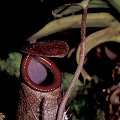Q: What is CITES?

Baby Nepenthes rajah
A: "CITES" stands for the "Convention on International Trade in Endangered
Species of Wild Fauna and Flora." This international convention concerns itself with the trade in
plants and animals (and their derivatives) across international borders. Because some species of animals and
plants (including
carnivorous plants) are increasingly rare, field collection by commercial
interests and hobbyists is a very real threat to the continued existence of
these species in the wild. To try to monitor and regulate the trade in these species, the
Convention in International Trade of Endangered Species (CITES,
usually pronounced sigh-tease) was created.
If you are trading plants internationally, you may need CITES permits.
Unfortunately, the collecting and trading goals of many enthusiasts conflict with
the trade regulations imposed by CITES. As you might expect, there is
a great deal of resentment by some carnivorous plant growers
towards CITES---not so much against its mission, but rather
against how it is implemented. Occasionally online carnivorous plant discussion groups reverberate with
angry stories of shipments unnecessarily delayed or stopped,
or less-than-competent inspectors.
I have not dealt first hand in plant trade requiring
CITES involvement, so haven't experienced such problems myself, nor can I determine
if the fault in these conflicts rests with CITES enforcement or the carnivorous plant
traders.
There is no question that CITES has helped raise the profile of unsustainable trade and collection, and
this has led to legislation and projects that ensure their sustainable use. But what about the
charges that CITES may block genuine conservation efforts? It seems to me that CITES only demands that
those engaged in international trade have the appropriate permits. There are only five carnivorous plant species which
are listed on Appendix I (more about that on the next FAQ page), but even these plants can be traded in
compliance with CITES as long as they are artificially propagated and are not derived from wild collected stock.
Any conservation efforts, including CITES, raises complicated questions.
My own bias is certainly pro-CITES, but I recognize that it is very difficult to understand the
rules and regulations for CITES, which makes it difficult to comply with.
I encourage those expert horticulturists who see problems with CITES, to contact the IUCN directly and
use their knowledge and expertise to ensure the species lists in the CITES Appendices make sense, and
that the CITES authorities in their countries know the conservation status of the species in trade.
Orchid growers have worked long and hard with CITES, and for example have gotten some orchid hybrids removed from
the Appendices.
If you're not happy with CITES, stop whining and contribute to improving it!
Page citations: http://www.cites.org; Simpson, R.B. 1994; personal observation.